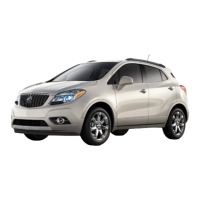

Do you have a question about the Buick 2013 Encore and is the answer not in the manual?
| Brand | Buick |
|---|---|
| Model | 2013 Encore |
| Category | Automobile |
| Language | English |
Guidance on how to effectively navigate and utilize the information within the owner's manual.
Provides context on vehicle handling and operational guidelines for safe driving practices.
Highlights critical safety messages, hazards, and necessary precautions to avoid injury or damage.
Explanation of various symbols used in the manual and on vehicle components for operational clarity.
A reference guide detailing the meaning of additional symbols that may be found on the vehicle.
Overview and identification of controls and displays located on the vehicle's instrument panel.
A brief overview of important features for the initial operation and familiarization with the vehicle.
Information on operating and securing the vehicle's keys, doors, and windows for safety and convenience.
Detailed instructions on adjusting seats, head restraints, and the proper use of safety belts and airbags.
Guidance on operating the vehicle's heating, cooling, and ventilation systems for cabin comfort.
Essential information on safe driving practices, vehicle controls, and operational procedures.
Procedures for routine checks, maintenance, and care of vehicle components to ensure optimal performance.
Guidelines for scheduled maintenance, required services, and special service procedures for vehicle longevity.
Specifications, identification numbers, capacities, and technical details for the vehicle.
Resources for customer satisfaction, safety reporting, data privacy, and dealer assistance programs.
Overview of the OnStar system, its services, operation, and additional information for users.
Information on vehicle keys, remote keyless entry systems, and locking mechanisms for security.
Details on operating vehicle doors, including the liftgate and safety lock functions.
Information on theft-deterrent features, including the vehicle alarm system and its operation.
Guidance on adjusting and operating exterior mirrors, including convex, power, and folding features.
Instructions for adjusting manual and automatic dimming rearview mirrors for optimal visibility.
Details on operating power windows, including express features and safety considerations.
Information regarding the vehicle's sunroof operation, features, and safety precautions.
Instructions on adjusting head restraints for proper seating and safety in the event of a crash.
Guidance on front seat adjustment, including power seats, lumbar support, and seatback recline.
Instructions on folding rear seatbacks for cargo space and rear seat belt usage.
Comprehensive information on safety belt usage, proper wear, and precautions for pregnant women.
Details on the vehicle's airbag system, locations, inflation, and important safety warnings.
Guidelines for selecting and securing child restraints, including age-appropriate recommendations.
Overview of various storage locations within the vehicle, including the instrument panel and console.
Information on features like cargo covers, cargo management systems, and convenience nets for storage.
Details on the proper use and limitations of the vehicle's roof rack system for carrying external loads.
Information on operating various vehicle controls, including steering wheel adjustments and audio controls.
Explanation of dashboard warning lights, gauges, and indicators that signal vehicle status or issues.
Details on the Driver Information Center (DIC), its displays, messages, and personalization options.
Overview of the vehicle's heating, cooling, and ventilation system controls and their functions.
Instructions on adjusting air vents to control airflow direction and volume within the cabin.
Information on maintaining the climate control system, including air intake and passenger compartment air filter.
Factors affecting vehicle performance and safety, including driver behavior and environmental conditions.
Guidelines for new vehicle break-in, ignition positions, starting the engine, and vehicle operation.
Details on the Antilock Brake System (ABS), parking brake, and brake assist features for safe stopping.
Explanation of Traction Control System (TCS) and StabiliTrak® system for enhanced vehicle stability.
Instructions for using the cruise control system, including activation, speed setting, and cancellation.
Information on Forward Collision Alert (FCA) and Ultrasonic Parking Assist systems for driver assistance.
Guidance on vehicle service, parts, and recommendations for maintaining the vehicle's condition.
Instructions for performing basic vehicle checks and owner maintenance tasks safely and effectively.
Step-by-step guide for replacing various exterior and interior light bulbs, including safety precautions.
Information on the vehicle's electrical system, including fuses, circuit breakers, and overload protection.
Guidance on tire maintenance, selection, pressure, wear indicators, and wheel care.
Importance of required maintenance for vehicle protection, performance, and value retention.
Schedule of owner checks, services, and interval-based maintenance tasks for optimal vehicle health.
Details on specialized services like chassis lubrication and underbody flushing for specific vehicle uses.
Recommendations for maintaining vehicle performance and avoiding future costly repairs through proactive care.
List of approved fluids, lubricants, and replacement parts essential for vehicle system maintenance.
A template to record service dates, odometer readings, and performed services for tracking maintenance history.
Information on identifying the vehicle, including VIN and service parts identification label details.
Key capacities and specifications for the vehicle, including fluid capacities and torque values.
Technical details about the engine, including VIN code, transmission type, and spark plug gap specifications.
Diagram illustrating the routing of the engine drive belt for the 1.4L L4 engine.
Resources for customer satisfaction, including procedures, assistance offices, and online owner centers.
Guidance on reporting vehicle safety defects to government agencies and General Motors.
Information on vehicle data recording, event data recorders (EDR), and privacy considerations.
Introduction to the OnStar system, its capabilities, status lights, and advisor contact information.
Details on OnStar services including Emergency, Security, Navigation, Connections, and Diagnostics.
Information on transferring service, reactivation for new owners, and how OnStar service works.











